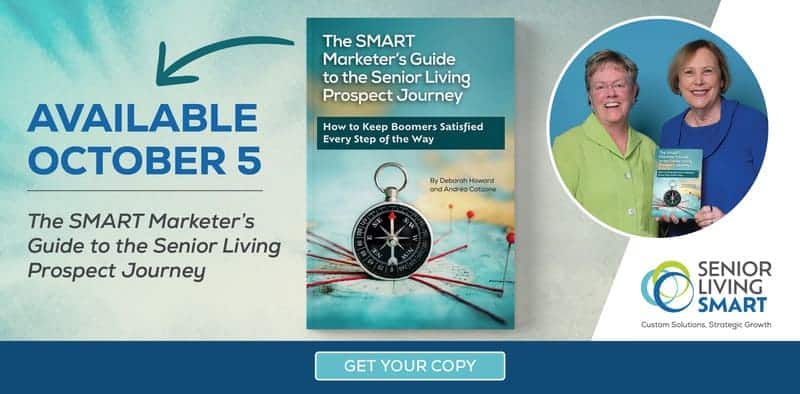What’s Trending in Senior Living Social Media Marketing
What’s hot right now in senior living social media marketing? Below, we’re sharing three trends we’re excited about, along with some mistakes you’ll want to avoid.
Trend #1: More Interest in Pinterest
If someone were to ask you what platform you think of when you hear the words “social media,” Pinterest probably isn’t the one that comes to mind. After all, it’s not a platform that dominates news cycles. While you can probably identify bigwigs at Facebook (Mark Zuckerberg) and Twitter (Elon Musk?!), you’d probably be hard-pressed to name Pinterest’s CEO, right? (For the record, it’s Ben Silbermann.)
And yet, Pinterest keeps chugging along—and has enjoyed increasing use among older adults.
According to 2021 stats from Statista, 38% of U.S. adults aged 50 to 64 use Pinterest, and 18% of U.S. adults over 65 use the platform. Compare that to 73% to 50% respectively for the same age groups for Facebook. While Facebook remains the top social media platform for people over 65, Pinterest comes in at a strong third, according to this article (YouTube is second).
Happily, we’re seeing more and more senior living communities embrace Pinterest, which is SMART. Because why wouldn’t you develop content where your prospective buyers are hanging out?
Trend #2: Did Someone Say YouTube?
YouTube is HUGE for seniors. In fact, nearly 50% of adults over 65 use YouTube. And don’t forget this nugget: Google owns YouTube, which means you can get an even bigger bang for your social media buck. Optimized videos DO come up in search—and some searchers prefer videos to articles.
So investing in a strong senior living social media marketing plan for YouTube could have many benefits:
- Increase engagement among target personas who enjoy using the platform
- Increase visibility for your brand
- Increase traffic from your YouTube videos to your site
Plus, you can use your YouTube videos in multiple ways. You can share them via other social media platforms, like Facebook, or use them in other media, like emails or embedded in your blog posts and other website pages.
We’re hoping more senior living communities jump on the YouTube bandwagon. While many have some video content on YouTube, communities need to be creating videos on a regular basis to get the biggest ROI. Luckily, this is easier today than ever before—armed with nothing more than a smartphone, ring light, lavalier mic, and a free editing app (like InShot), today’s marketing teams can create quick videos on the fly. (The challenge is getting over the fear of this DIY method!)
Check out what one of our awesome clients, Ingleside Senior Living, is doing with its YouTube channel. They post videos regularly. They post a variety of videos. They have separate playlists for each community (which is a smart way to approach this issue). And their videos are excellent.
We particularly love this “Meet Your Future Neighbors” video that’s racked up over 600 views. Notice how simple it is–no fancy production, no mics, everyday lighting.
Trend #3: Thinking Beyond Selling
At its simplest, marketing’s main job is to attract qualified leads and help turn those leads into move-ins. So it’s easy to think every marketing tactic has to be about selling, selling, selling. But social media is a different animal. It’s supposed to be social after all! If you’re constantly in sales mode, you’re going to turn people off.
The senior living communities that have the most success with social media are ones that think beyond selling. They relax and keep their feeds real. And here’s the thing: They’re reaping the benefits of this approach. Because oftentimes authentic, feel-good posts will provide lots of engagement and increased exposure for your brand. While harder to quantify, we’d argue that these things are just as important.
Luckily, more communities are taking this approach with their social media marketing. You might have heard about Wheatland Manor’s “Advice for the Younger Generations” campaign, where the community shares images of residents holding whiteboards with solid advice like “Get a job you enjoy” and “Play Uno with your grandma.” These images have gone viral and have racked up tons of likes.
One particular community of our client Senior Star, Senior Star at Wexford Place, has embraced the concept of “thinking beyond selling.” The community does an awesome job with its social media feeds by highlighting cool things residents do and by offering regular shout-outs to staff. Below is an example of a staff shout-out. Note the fabulous engagement!
Other smart ways to “think beyond selling”:
- Share resident spotlights. For example, got veterans? Highlight them on Veterans Day. Got residents with green thumbs? Share pics of them tending to their gardens and flower boxes.
- Share resident quotes/testimonials. These work great with the hashtag #TestimonialTuesday.
- Share pics from all of your activities, large and small. Pictures and videos get tons of engagement.
Mistakes people are (still) making with their senior living social media marketing
Not all trends are good trends. Unfortunately, many senior living marketers are still making the following mistakes.
Mistake #1: Not having a sharp focus.
Trying to maintain a presence on every social media platform under the sun will never work. Why? Well, effectively managing multiple platforms is challenging unless you have a person on staff devoted entirely to this effort—and most communities don’t.
What happens next is predictable. The existing team will either end up diluting their efforts across the numerous platforms, or the team will give up altogether. And nothing is worse than a community’s social media channels going dark.
Thankfully, this trend is slowing down in favor of a NEW trend, which we refer to as “finding focus.” When you focus on two or three platforms that make the most sense for your personas, the better the results.
So how do you focus? Again, it goes back to knowing your community’s target personas and where they hang out online. And here’s the thing about social media—tastes will evolve. Ten years ago, it was all about Facebook and Twitter. Pinterest was just a baby, only a couple of years old.
The thing you need to remember: When it comes to social media, early adopters are usually younger people. While older people eventually follow, it takes time. Our point: Communities who try to maintain Facebook, Twitter, LinkedIn, Pinterest, Instagram, YouTube, and TikTok probably won’t do as well as a community that focuses on two or three—say Facebook, YouTube, and Pinterest.
We know what you’re thinking . . . WHAT ABOUT TIKTOK? While it’s tempting to get on board the TikTok train, keep in mind that only 3.4% of TikTok users are over 65. You might argue, “Well, we’ll have an awesome presence for when older adults DO flock to TikTok.” Maybe. But there’s no guarantee that will happen—and definitely no guarantee it will happen any time in the next 2-3 years. Why invest resources into TikTok when you could put those resources to better use—like on a platform where your personas are actually hanging out?
Mistake #2: Not paying attention to responses . . . and results.
With social media, it’s easy to get lost in the weeds. You’re so busy coming up with compelling content that you’re not spending any time analyzing results. And by “results,” we mean engagement.
- What types of posts get the most likes, shares, and comments?
- Can you glean anything about the days you post—or the times of day?
- Are you using hashtags appropriately? (Using too many can be a turn-off for followers.)
In our experience with clients, Fridays, Saturdays, and Sundays tend to garner more engagement than weekdays, but of course, your mileage might vary. Another mistake communities make: Not posting enough. We recommend posting three to five times a week to keep audiences engaged. Again, pay attention to what works, and don’t be afraid to experiment.
Finally, make sure you respond to people’s comments! If they’ve taken the time to comment on your content, the least you can do is like (or heart) their comment. Some comments, particularly reviews, warrant actual responses from you. For positive reviews, thank the person for sharing their experience. For negative reviews, tread carefully, but you should still acknowledge the person’s concerns. (Check out this article with tips on how to respond to reviews.)
Mistake #3: Treating your social media marketing strategy like a static “thing.”
Senior living social media marketing is a moving target, which can be frustrating for many marketing and sales teams. It’s tempting to get into a rhythm—and to stick with that rhythm FOREVER. But that’s not a smart long-term strategy.
What worked a year or two ago might not work today. At the same time, you don’t want to jump on the hot new platform (or what seems hot, anyway) while abandoning an effective strategy.
It’s a tightrope, for sure, but one that all successful marketing teams must learn to walk. Our advice: Pay attention to so-called trends. But more importantly, pay attention to what’s currently working for your feeds. Don’t be afraid to experiment, but let the results guide where you invest money and resources.
And know that things will change over time. Some platforms will fade in popularity while others will take their place. As Boomers age, your social media strategy will surely evolve since Boomers are much more active on social media than the 75+ crowd currently is. These are things to keep in mind as you strategize.
Want to rock your community’s social media channels, but you’re not sure what to do next?
You don’t need to go it alone. We help senior living communities develop engaging content that garners plenty of likes, shares, comments, and even leads. Let’s talk about your community’s social media needs.




